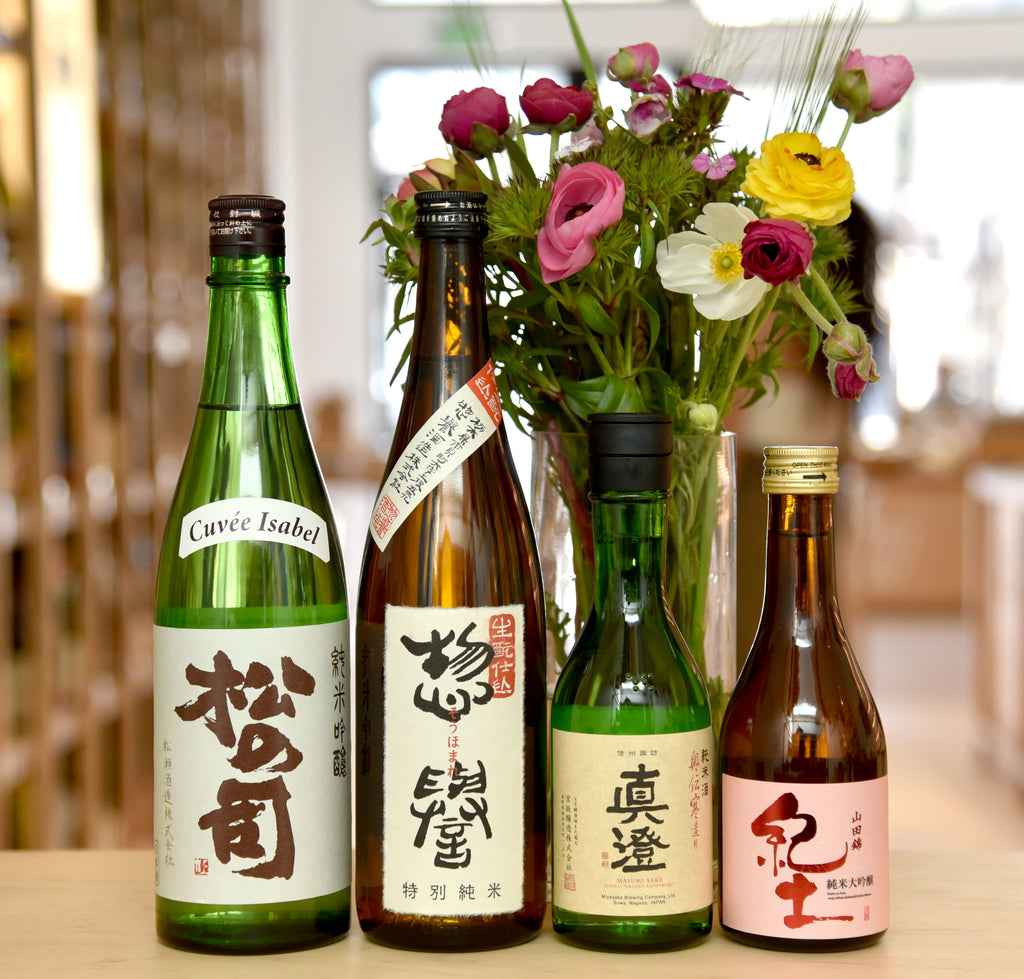
Sake Gumi is our monthly sake subscription service with 200 members throughout the country. Join today!
These days, there has been a bit of buzz about blending for sake, with the emergence of bottles blended by legends of the wine world in Europe and Canada. The concept of blending is little discussed in sake, even though it has been practiced for centuries in Japan.
I’m taking over this month for Sake Gumi and excited to feature sakes that have been blended in one form or another. This idea came to me while visiting Matsuse Brewery in Shiga Prefecture earlier this year with Yoko – Toji Keizo Ishida showed us several tanks that were in the midst of aging and spoke passionately about blending his sakes with purpose. Ishida-san is an avid wine lover who believes sake can have a deeper complexity when blended, and has been experimenting with blending different vintages of his sakes through the years. The result is Cuvée Isabel, his blended bottle debut that I’m proud to feature for Level Two – read more about my visit to Matsuse on our blog.

Tasting through several sake vintages with Ishida-san at Matsuse Brewery
There’s a more practical reason why brewers blend sakes: sake brewers make painstaking efforts year after year to achieve a consistent taste and style, which is why blending works so well for them (as it does for whisky). About our featured bottle for Level One, “For Okuden Kanzukuri, which is a product that is on the market all year long, the kind of blending we perform is between newer and older batches of the same sake, and the aim is to maintain consistent flavor and maturity no matter when it is purchased,” says Toji Kenji Nasu of Miyasaka Brewery. As for historical context, Nasu-toji comments, “[I assume that] any brewery large enough to have a surplus that runs across two brewing years will have been doing this for many hundreds of years.”
Yeast blending is another technique practiced throughout Japan, which is demonstrated with Kid Junmai Daiginjo; Sohomare Kimoto Junmai takes it a step further by blending three sakes made with three different yeasts. I spoke with a few local makers to wrap my head around blending.
Nate Darling of Pekut + Carwick, who blends spirits, said, “All alcoholic beverages are agricultural by nature, so there is always variability. At the same time, there has always been a need to produce spirits with compelling and marketable flavor profiles. For as long as there have been markets for [alcohol], blending has bridged this gap.” About the craft of blending, Chris Brockway of Broc Cellars winery added, “What I like about blending is it allows you to make something new and unique.”
Kanpai to sake blends,
Kayoko |
Co-Founder, Umami Mart

Heiwa “Kid” Junmai Daiginjo
Heiwa Shuzo (Wakayama, Japan)
Seimaibuai: 50% Yamadanishiki, SMV: +2, Acidity: 1.3, Yeast K901 + K1801
Heiwa has been making this sake since 2011, blending two kinds of yeasts. “The purpose of the yeast blend is to increase the fermentation power. As for the flavor, I try to bring out the apple and muscat scents that are characteristic of 1801,” says Heiwa toji Hidemichi Shibata.” We use 1801 yeast to bring out the gorgeous aroma, but 1801 alone produces too much aroma and the fermentation is weak, so we blended No. 9 yeast.” Get a bouquet of fresh spring flowers and bright fruits on the nose. The palette is summery cucumbers and melon, so serve cold with fresh ceviche and raw Totten Inlet oysters.

Masumi Okuden Kanzukuri “Mirror of Truth” Junmai
Miyasaka Jozo (Nagano, Japan)
Seimaibuai: 70% Sankei Nishiki, Miyama Nishiki, Hitogokochi SMV: +1, Acidity: 1.8, Yeast: In-house No. 7
Miyasaka Jozo is well known in Japan and abroad, and its making its Sake Gumi debut with this bottle that has been on the market since 1982. Blending between the newest batch of sake with last year’s yield, the brewery makes sure the bottle tastes exactly the same year after year with this method. This is a versatile and elegant junmai with a balanced acidity that pairs well with anything from a salad nicoise, to Milk Street’s Lemon-Garlic Shrimp Spaghetti or tacos from El Tucan in Richmond. Enjoy it any night of the week at room temperature to get a bold but clean mouthfeel.

Cuvée Isabel Junmai Ginjo
Matsuse Sake Brewery (Shiga, Japan)
Seimaibuai: 65% Yamada Nishiki, Ginfubuki + Wataribune
SMV: +1, Acidity: 1.5, Yeast: Kanazawa Yeast #14

Inspired by the blending practices of Champagne and whisky, Ishida-toji created this supple brew using five sakes brewed in 2020, 2019, and 2018. “By combining various unblended sakes, we express a complexity that cannot be achieved by bottling a single batch alone,” says Ishida-toji. He has created just that – a sake that is multi-layered yet mellow, best enjoyed at room temperature from a guinomi cup, with slices of kamaboko (fishcake, my fave). Along with a plate of ten-zaru soba from Soba Ichi, you are set!

Sohomare Tokubetsu Kimoto Junmai
Sohomare Brewery (Tochigi, Japan)
Seimaibuai: 60% Yamadanishiki, SMV: +4, Acidity: 1.8, Yeast No. 6 + 7 + 1401
Also new to Sake Gumi, we welcome Sohomare Brewery’s flagship sake! Sohomare is known for their kimoto sakes, and uses a technique akin to the Solera method, adding the newest sake with blends from years past. In addition to this, they blend sakes that are made with different yeasts: “By blending sakes made with three different types of yeasts, we are able to produce a sake with a high degree of complexity.” says Jun Kono, president of Sohomare Brewery. This is an awesome sake with juicy, citrus notes that pairs well with tonkatsu or a soft-ripened bloomy goat cheese.




Comments (0)
There are no comments for this article. Be the first one to leave a message!